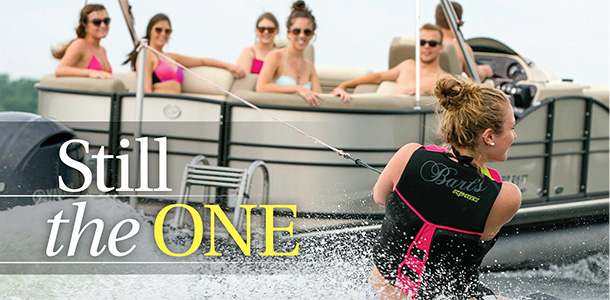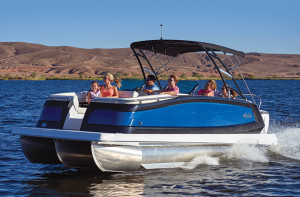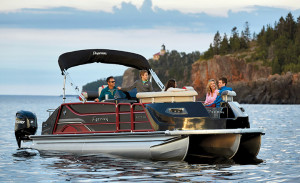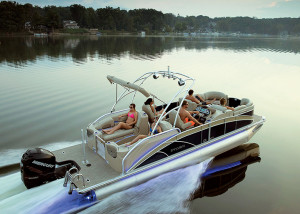Market Trends: Pontoon segment stays strong

Pontoon boats drove the boating industry’s rebound in the wake of the downturn. But are they still leading the way?
Since the 2008 economic downturn, pontoon boats have led the recovery of the recreational boating industry. At one point accounting for almost one in three new boats sold, the pontoon market has demonstrated unprecedented growth, with new players jumping into the fray and established nameplates pumping out new models at an accelerated rate. It begs the inevitable question – how long can this really last?
In view of current economic and socio-demographic trends, the upswing in pontoon sales is going to last for a while yet. After years of exhibiting double-digit expansion, the category has settled into more sustainable growth in the high single-digit range, suggesting we’re witnessing more of a boom than bubble. The most recent NMMA year-over-year retail sales data shows the pontoon segment growing by 8 percent for 2015.
This aligns with September 2015 data from Statistical Surveys Inc., which shows U.S. retail sales of all pontoons at 39,857 units on a 12-month rolling basis, up from 36,920 units for the previous 12-month period. Boats in the 20- to 23-foot range represent the overwhelming majority of these sales, totaling 20,608 units or just over half of the 39,857 pontoon boats sold through the 12 months ended September 2015.

In a November presentation to shareholders, Brunswick freshwater boat group president Jeff Kinsey noted that pontoon boat sales have recovered to 103 percent of their pre-downturn (2007) levels in the United States.
“We’re still seeing very strong pontoon growth, but not the runaway growth we witnessed coming out of the recession, when we had a recovering economy compounded with a number of new dealers beginning to sell pontoon product, and driving overall sales in such a powerful way,” he said. “We see strong growth in the pontoon segment continuing for some time yet. The demographics are favorable, and we’re seeing a number of lifelong boaters now looking at pontoon product. At the same time, we’re also seeing growth within the segment from buyers in their 20s and 30s with families. It is a category that appeals to a tremendously wide range of prospective buyers.”
Recognizing the growth for potential, Cobalt Boats has expanded into the pontoon market with its Marker One brand.
“Measured in units, the pontoon segment in the 23- to 27-foot range is four times larger than the sterndrive segment in the same size range,” notes Gavan Hunt, vice president of sales and marketing for Cobalt/Marker One. “Marker One represents a significant opportunity for us to grow our overall business. Cobalt was founded on the premise of bringing yacht quality to a runabout, and Marker One is built on the premise of bringing yacht quality to a pontoon-style boat.”
Power options drive the market
Reasons for the surge in pontoon market share have been well documented – the type’s versatility, flat floor and spacious accommodations appeal to buyers who don’t need or want accommodations below decks. But engine technology continues to be identified as a key driver of growth in the pontoon segment.

“We’re still seeing particularly strong interest in performance models powered by high horsepower engines,” said Peter Barrett, senior vice president of marketing for Smoker Craft Inc., manufacturer of the Starcraft, Sylvan and SunChaser pontoon lines. “We’re seeing far more demand for three-tube high performance models than ever before – to the point we had to set up a whole new production line to accommodate it. Developments in outboard engine technology have definitely contributed to the growth of pontoons by making the boats more versatile than ever.
“But while it’s easy to point to the bigger engines and the high performance aspects, the great thing about pontoon boats is that they’re so scalable,” notes Barrett. “You can put a 200 on the back, or go with a less expensive 115 and still have a great time out on the water. This gives dealers a great deal of flexibility, so they can more effectively meet the needs of their customers.”
Although virtually every pontoon builder would agree that advances in outboard technology have benefited pontoon sales, advances in electric power have also contributed to the category’s continued growth. Electrically powered pontoons have become the boat of choice on countless lakes across the U.S. and Canada with gas engine or horsepower restrictions.

“Pontoon boats are particularly well-matched to electric power,” said Torqeedo Inc. president, Steve Trkla. “We recognized this almost seven years ago when we came out with our first Cruise motor. Today we work with 18 different pontoon boat manufacturers, with either factory programs or programs at the dealer level. The reason electric propulsion works so well with pontoons is because of its high torque. It has the power to move a large load easily. At the same time, battery technology continues to develop at a rapid pace, which allows more power and greater run times while taking up less space in the boat.”
 Trkla expects demand for electrically powered pontoons to continue to grow, and not just as a result of increasing numbers of lakes in parts of the country coming under horsepower restrictions.
Trkla expects demand for electrically powered pontoons to continue to grow, and not just as a result of increasing numbers of lakes in parts of the country coming under horsepower restrictions.
“We’re seeing more and more environmental regulations around simply having gas pumps on lakes,” he notes. “In some areas we know of lakes where gas is no longer available on the water, because the cost of meeting new environmental regulations was so high that the marina just said forget it, it’s not worth the trouble. As the time comes for marinas to update or replace their fuel storage facilities, we’re going to see this come up more and more. For the boater, it’s a whole lot easier to just plug the boat in at the end of the day than it is to continually have to drive into town with a couple of Jerry cans, and have to keep hauling them up and down to the dock. So we expect demand for electric outboards will continue to grow, and most of those engines will likely be pushing pontoons.”
Master of versatility
Regardless of how it may be powered, pontoon boats stand unmatched in terms of comfort and versatility. With their single deck layout, comfortable furniture, spacious layouts and their ability to do so many different things well, pontoons have clearly gained market share at the expense of other categories.
“I believe pontoons will absolutely continue cannibalizing other industry segments,” observes Kinsey. “Unless you tow the boat frequently, or you’re a professional wakeboarder or tournament fisherman, a pontoon is the most versatile boat you can own. I’m reminded of a colleague I used to work with, who once said the most selfish purchase a man can make is a bass boat, since that represents a commitment to spend a lot of weekends away from your family. But that’s not at all true with a pontoon. A pontoon is a commitment to spend time with your family, and it is the versatility of the design which makes that possible.”

If there is one segment that has felt the impact of the pontoon market more than any other, it is the small cruiser segment. Where pocket cruisers under 30 feet were once strong sellers, they have almost disappeared with the rise of the pontoon category.
“We surveyed owners of small cruisers, small being defined as less than 30 feet in overall length, and found less than 10 percent of them actually used the overnight accommodation in their boat,” said Brunswick Corporation CEO Dusty McCoy in his keynote presentation at the 2013 Marine Equipment Trade Show (METS). “We found they mainly use the cabins for storing their gear.”
Pontoons fit with McCoy’s further observation that boating needs to become less expensive, telling the METS audience, “As an industry, we’re beginning to price ourselves out of business.” Pontoons fit that bill, since a cruiser with comparable seating capacity generally costs much more to buy and considerably more to operate.
“Pontoons are taking market share from other segments, particularly in the high-end and performance-related product,” said Premier Pontoons president Lori Melbostad. “It’s all about having more space. A 30-foot pontoon gives you so much deck space compared to a 30-foot cruiser, where everyone sits together rubbing elbows in that little pocket of open cockpit in the stern. Today the upholstery and appointments are on par with, or nicer than, what you have in a similarly sized cruiser. The pontoon offers far more space and versatility, and with our recent innovations we can also offer the boater overnight accommodations to meet that need as well.”
Campion Marine, a fiberglass cruiser and runabout manufacturer, added a fiberglass pontoon product (named the Biltmore “Fibertoon”) to its product line in 2013.
“The premium pontoon market doesn’t face a lot of price sensitivity because the primary competitor is a cruiser,” said Brock Elliott, president of Campion Marine. “Compare a pontoon to a cruiser with the same seating capacity and capabilities, and the pontoon will win every time. Our Biltmore product is a premium, high-end product, yet we have not faced any sort of resistance to its pricing whatsoever. When people see what they get for their money, they realize the value just can’t be beat.”
For sterndrive runabout manufacturer Cobalt, the decision to add a pontoon line was easy.

“The buyer for a Marker One product is the same person as the buyer for a Cobalt, they just have different ideas on how they want to spend a day on the water,” explains Hunt. “For some families, that’s cruising, wakeboarding, towing a tube, doing some skiing or entertaining friends, and that’s where the floating living room works very well. We’re committed to growing our business in this segment.”
While there are many factors identified as contributing to continued growth of the pontoon segment, retained value is one aspect that flies under the radar. Late-model pontoons are easy sales on the used market, and at least right now, they appear to retain their value better than some other types of boats.
“We have a lot of repeat buyers, which has spawned a growing market for used pontoons,” said Melbostad. “Whether it’s a resale or a trade-in, the boater can still get a decent dollar for their old pontoon when they move up to a new one. And because they’re outboard-powered, the dealer has a lot more flexibility when the time comes to sell a trade-in pontoon since they can be repowered so much more easily than a boat with an inboard or a sterndrive.”
The long view
In spite of a plethora of new nameplates and new models, industry consensus seems to be that the pontoon category will continue to exhibit high single-digit growth for at least the next 18 to 24 months.
Growth may even creep back into double digits if the category can be developed in export markets. With several manufacturers expressing an interest in doing just this – SunChaser even introduced an all-new Traverse series this year, specifically designed to fit into a standard shipping container – export may represent an entirely new growth opportunity. Where the cost to ship full-sized boats was once identified as a significant barrier to exporting, with top-end units now boasting retail price tags approaching or surpassing six figures, the relationship between shipping expense and retail price isn’t much different than it is for fiberglass boats, which have been exported worldwide for years.





Premier Pontoon Boats were the first to offer a premium product. Bob and Betty are the best ambassadors the pontoon industry could have. I new the man who put together the first good center pontoon at Premier Marine Inc.
Nothing runs like a Premier center pontoon boat. Keep up the good work Lori.
Best regards,
To All!!!